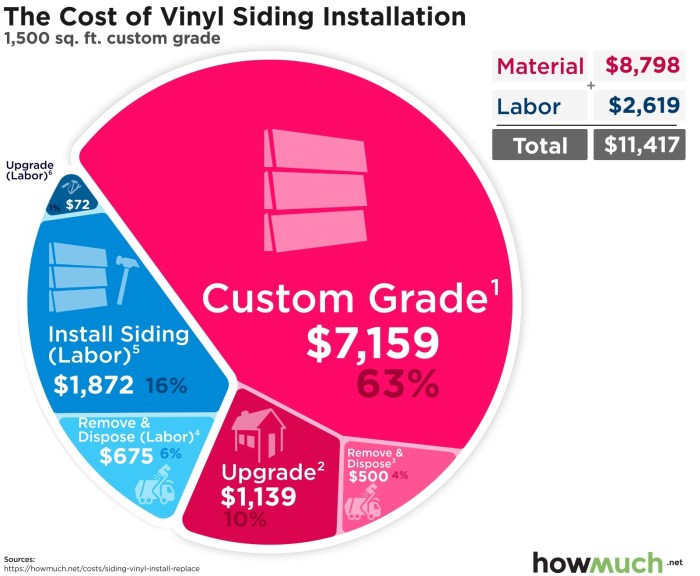Vinyl Siding Estimate Cost A Homeowners Guide

Vinyl siding estimate cost: Want a beautiful new exterior without breaking the bank? Understanding the cost of vinyl siding is key. This guide breaks down everything you need to know, from the factors influencing price to smart strategies for saving money. We’ll explore material choices, labor costs, regional differences, and even potential hidden expenses, so you can feel confident in your decisions.
Getting accurate estimates is crucial. We’ll walk you through how to get multiple bids, ask the right questions, and spot potential red flags from contractors. Learn how house size and complexity, as well as the time of year you choose for installation, affect the bottom line. We’ll even cover the pros and cons of DIY versus professional installation. By the end, you’ll be equipped to navigate the world of vinyl siding costs with ease and confidence.
Factors Influencing Vinyl Siding Estimate Cost
Getting an accurate estimate for vinyl siding installation involves considering several key factors. The total cost isn’t just about the square footage of your home; it’s a complex calculation influenced by material choices, labor rates, and the intricacies of your home’s design. Understanding these factors will help you better prepare for the project and manage your budget effectively.
Material Quality and Pricing
Vinyl siding comes in a wide range of grades, each impacting the overall cost. Premium vinyl siding, often featuring thicker materials, enhanced durability (like impact resistance), and more realistic wood-grain textures, will command a higher price per square foot compared to budget options. Budget vinyl siding, while less expensive upfront, might be thinner, less durable, and fade faster, leading to potential higher long-term costs. For instance, a premium vinyl siding might cost $8-$12 per square foot, while a budget option might range from $3-$6 per square foot. These price differences reflect variations in material composition, manufacturing processes, and warranty coverage. The increased initial investment in premium siding can often be justified by its longevity and superior performance.
Labor Costs and House Complexity
Labor costs represent a significant portion of the overall project expense. The complexity of your home’s design significantly affects the time and effort required for installation. A simple, single-story house with few architectural details will require less labor than a multi-story home with intricate trim, dormers, or complex angles. Features like bay windows, columns, or multiple rooflines add complexity, increasing both material needs and labor hours, thus boosting the overall cost. A simple rectangular house might take a crew two days to complete, while a complex Victorian might require a week or more.
Regional Variations in Pricing
Vinyl siding installation costs vary considerably across different regions of the country. Factors such as labor rates, material availability, and local market competition all play a role. Areas with a higher cost of living generally have higher labor costs, impacting the final price. Additionally, transportation costs for materials can also influence regional price differences.
| Region | Average Cost ($/sq ft) | High Cost ($/sq ft) | Low Cost ($/sq ft) |
|---|---|---|---|
| Northeast | $8.00 | $12.00 | $5.00 |
| Southeast | $7.00 | $10.00 | $4.00 |
| Midwest | $7.50 | $11.00 | $4.50 |
| Southwest | $6.50 | $9.00 | $3.50 |
| West Coast | $9.00 | $13.00 | $6.00 |
Note: These are estimated ranges and actual costs can vary based on specific project details. These figures are based on averages gathered from various sources and should be considered illustrative rather than definitive. Always obtain multiple quotes from reputable contractors in your area for accurate pricing.
Breakdown of Vinyl Siding Installation Costs

Source: ctrlcalculator.com
Getting vinyl siding installed can seem straightforward, but the total cost is made up of several key components. Understanding these individual costs helps you budget accurately and avoid unpleasant surprises during the project. This breakdown will clarify the different expenses involved, providing a clearer picture of what you can expect to pay.
A typical vinyl siding installation involves a combination of material costs, labor charges, necessary permits, and potential unforeseen expenses. The percentages allocated to each component can vary depending on factors like the house size, siding quality, complexity of the job, and regional labor rates. However, a general understanding of these cost categories is crucial for effective planning.
Material Costs
Materials represent a significant portion of the overall cost. This includes the vinyl siding itself, along with any necessary trim, flashing, and underlayment. The type of siding you choose, its quality, and the amount needed based on your home’s size directly influence this cost. Higher-quality siding, while more expensive upfront, can offer better longevity and aesthetic appeal.
- Vinyl Siding: This is usually the largest material expense, ranging from $1 to $8 per square foot depending on the style, color, and manufacturer. A mid-range option might cost around $3 per square foot.
- Trim and Accessories: This includes J-channel, corner trim, window and door trim, and other necessary pieces to create a clean and professional finish. Expect to allocate a percentage of the total material cost to these items, typically 10-20%.
- Underlayment: This moisture barrier protects your home’s exterior walls and contributes to energy efficiency. Costs vary depending on the type used, but it’s a relatively small portion of the total material cost, usually around 5-10%.
Labor Costs
Labor costs are typically the second-largest expense. Experienced installers are crucial for a proper, long-lasting installation. The complexity of your home’s exterior, such as the number of windows, doors, and architectural details, will influence the labor time and therefore the cost. Hourly rates and the total number of labor hours required will determine the final labor cost.
- Installation: The majority of labor costs are associated with the actual installation of the siding, trim, and accessories. This often involves removing old siding, preparing the walls, and carefully installing the new siding according to manufacturer specifications.
- Preparation: This includes tasks like cleaning the exterior walls, repairing any damaged areas, and ensuring a level surface for the new siding. The level of preparation required influences the labor time and therefore the cost.
Permits and Other Expenses
While often overlooked, permits and other miscellaneous expenses can add up. Building permits are necessary in most areas for exterior renovations, and their cost varies depending on location and project scope. Other expenses might include waste removal, dumpster rentals, or specialized tools needed for the job.
- Permits: Expect to allocate a small percentage of the total budget for permits, typically 1-5%, depending on local regulations and project complexity.
- Waste Removal: Proper disposal of old siding and other debris is important. This expense is often included in the contractor’s quote, but it’s good to clarify this upfront.
Example Cost Breakdown: 1500 sq ft Home
Let’s consider a hypothetical 1500 square foot home with mid-range vinyl siding. This is just an example, and actual costs will vary based on location and specific circumstances.
| Cost Component | Cost per sq ft | Total Cost | Percentage of Total |
|---|---|---|---|
| Materials (Siding) | $3.00 | $4500 | 30% |
| Materials (Trim & Accessories) | $0.75 | $1125 | 7.5% |
| Materials (Underlayment) | $0.30 | $450 | 3% |
| Labor | $5.00 | $7500 | 50% |
| Permits | $0.50 | $750 | 5% |
| Waste Removal | $0.25 | $375 | 2.5% |
| Total Estimated Cost | $15000 | 100% |
Potential Hidden or Unexpected Costs
Unforeseen issues can arise during installation. Discovering rotted wood under the old siding, needing extensive wall repairs, or encountering unexpected plumbing or electrical issues can significantly increase the final cost. To mitigate this risk, always get a thorough inspection and multiple detailed estimates before committing to a project.
- Wall Repairs: Addressing rotted wood or other damage before siding installation is crucial. A pre-installation inspection can help identify and budget for these repairs.
- Unexpected Structural Issues: Problems like termite damage or foundation issues discovered during the process require additional work and cost.
- Changes in Scope: Once the project begins, you might decide to make changes, such as adding more features or upgrading materials. This can lead to additional costs if not planned for upfront.
Obtaining Accurate Estimates

Source: cdn-website.com
Getting the best price for your vinyl siding installation requires careful planning and research. Don’t rush into a decision based on the first estimate you receive. Taking the time to compare multiple bids will save you money and potential headaches in the long run. Remember, the lowest bid isn’t always the best deal; you need to consider the overall value and reputation of the contractor.
Getting multiple estimates from different contractors is crucial for ensuring you receive a fair and accurate price for your vinyl siding project. This allows you to compare not only the cost but also the quality of materials, the scope of work, and the contractor’s experience and reputation. By comparing multiple estimates, you can avoid overpaying and choose a contractor who best meets your needs and budget. Consider getting at least three estimates to have a good comparison.
Key Questions to Ask Potential Contractors
Before accepting any estimate, you should have a clear understanding of what’s included in the price. Asking the right questions ensures transparency and helps you compare apples to apples. Vague or evasive answers should raise red flags.
- What specific materials will be used (brand, type, warranty)? Knowing the exact brand and model of siding, underlayment, and other materials ensures consistency and allows you to research their quality and longevity.
- What is the detailed breakdown of labor costs? A clear breakdown should specify the cost per square foot, the number of hours estimated for each phase of the project (removal of old siding, preparation, installation, cleanup), and any additional charges for permits or disposal fees.
- What is the timeline for the project? This includes start and completion dates, as well as potential delays and how they’ll be handled.
- What is your company’s insurance and licensing information? Verify this independently to ensure they are properly insured and licensed to work in your area.
- Can I see examples of your previous work? Request photos or addresses of completed projects similar in size and scope to your own.
- What is your warranty policy for both materials and workmanship? A comprehensive warranty protects your investment.
- What is your payment schedule? A reasonable payment schedule usually involves a down payment, progress payments tied to milestones, and a final payment upon completion.
Red Flags Indicating Unreliable Contractors
Certain signs should make you wary of a contractor’s reliability and the accuracy of their estimate.
- Unusually low bids compared to others. This often indicates corners will be cut, substandard materials will be used, or the scope of work might be incomplete.
- High-pressure sales tactics. A reputable contractor will respect your decision-making process and won’t pressure you into signing a contract immediately.
- Lack of detail in the estimate. A vague or incomplete estimate is a red flag, indicating a lack of professionalism and transparency.
- Refusal to provide references or proof of insurance and licensing. This suggests a lack of accountability and could leave you vulnerable to problems.
- Inconsistent or unclear communication. Difficulties in getting answers to your questions or receiving timely updates are warning signs.
Essential Items for a Formal Written Estimate
A comprehensive written estimate protects both you and the contractor. It should articulate the scope of work and prevent misunderstandings.
- Contractor’s name, address, phone number, and license number.
- Project address.
- Detailed description of the work to be performed, including materials and quantities.
- Specific brands and models of materials to be used.
- Complete price breakdown, including labor, materials, permits, and disposal fees.
- Payment schedule.
- Project timeline with start and completion dates.
- Warranty information for both materials and workmanship.
- Start and completion dates.
- Cancellation policy.
Saving Money on Vinyl Siding Installation
Getting new vinyl siding can significantly improve your home’s curb appeal and energy efficiency, but the cost can be substantial. Fortunately, there are several ways to reduce the overall expense without compromising on quality. By carefully planning and strategically negotiating, you can save a considerable amount of money on your project.
Smart planning and proactive strategies are key to keeping vinyl siding installation costs down. This involves careful consideration of material choices, contractor selection, and timing of the project. Negotiation skills also play a significant role in achieving a more favorable price. Finally, understanding the potential savings and risks associated with DIY installation versus professional work is crucial for making an informed decision.
Negotiating with Contractors for Lower Prices
Effective negotiation can significantly lower your final cost. Start by obtaining multiple detailed estimates from different contractors. Compare not only the total price but also the breakdown of costs for materials and labor. Don’t hesitate to ask for clarification on any items you don’t understand. Consider negotiating on aspects like the project timeline – contractors might offer a discount for off-season work. Finally, clearly state your budget upfront; this allows contractors to tailor their proposals accordingly, and can encourage them to offer competitive pricing to secure your business. For example, if you’re willing to provide some of the preparatory work yourself (e.g., removing old siding), you might be able to negotiate a reduced labor cost.
Seasonal Pricing Variations for Vinyl Siding Installation
The time of year you choose for installation can significantly impact the overall cost. Contractors often have lower prices during the off-season (typically winter) because demand is lower. However, keep in mind that weather conditions can impact the installation process during winter months, potentially leading to delays or additional costs. Conversely, peak seasons (spring and summer) usually command higher prices due to increased demand. Weighing the cost savings against potential weather-related delays is crucial when deciding on the best installation time. For instance, a contractor might offer a 10-15% discount for a winter installation compared to a summer installation.
DIY Vinyl Siding Installation vs. Professional Installation
DIY installation offers the potential for substantial cost savings, as you eliminate the labor costs charged by professional installers. However, this approach demands significant time commitment, specialized tools, and a considerable level of skill and experience. Incorrect installation can lead to problems like water damage, which can far outweigh any initial savings. Before attempting a DIY installation, honestly assess your skills and resources. If you lack the necessary experience, the risks associated with improper installation might make professional installation a more cost-effective and less stressful option in the long run. Consider the cost of renting specialized tools and the potential cost of rectifying mistakes before making your decision. A professional installation guarantees quality workmanship and protects you from costly future repairs.
Visual Representation of Vinyl Siding Costs: Vinyl Siding Estimate Cost

Source: estimatorflorida.com
Understanding the cost of vinyl siding installation can be challenging, especially for larger, more complex homes. Visualizing the breakdown helps homeowners grasp the financial implications of different aspects of the project. Let’s consider a hypothetical scenario to illustrate this.
We’ll imagine a two-story house with 2,000 square feet of wall space. This house features complexities that increase installation time and material costs, such as a large dormer window on the second story, a bay window on the first floor, and several intricate architectural details around the eaves and trim.
Cost Breakdown for a Complex Two-Story House
Let’s assume a base cost of $5 per square foot for standard vinyl siding installation. However, the complexities of our hypothetical house will significantly impact this base price.
| Area | Square Footage | Cost per sq ft | Total Cost |
|---|---|---|---|
| Main Walls | 1500 | $5 | $7500 |
| Dormer | 100 | $8 | $800 |
| Bay Window | 150 | $10 | $1500 |
| Trim & Detailing | 250 | $12 | $3000 |
| Total | 2000 | $12800 |
This table shows a significant increase in cost per square foot for areas requiring more intricate work. The total cost for this project is $12,800.
Visual Representation of Cost Breakdown, Vinyl siding estimate cost
Imagine a bar graph. The horizontal axis represents the different areas of the house (main walls, dormer, bay window, trim). The vertical axis represents the cost. The bar for “main walls” would be the longest, reflecting the largest area and therefore the largest cost. The bars for the dormer, bay window, and trim would be progressively shorter, reflecting their smaller areas and the increased cost per square foot. The color of the bars could be graded, with darker shades representing higher cost per square foot. This visual clearly shows where the majority of the cost is concentrated.
Cost Comparison of Different Vinyl Siding Options
Now, let’s visualize the cost differences between various vinyl siding choices. Imagine a pie chart. Each slice represents a different siding option (e.g., standard grade, premium grade, different colors). The size of each slice directly correlates to its cost. For instance, a premium grade siding with a complex color might occupy a larger slice than a standard white siding. Different textures could be represented by different patterns within each slice, further emphasizing the cost variations between options. This pie chart provides a clear comparison of the relative costs of different siding options for the entire 2000 square foot house. For example, upgrading to a premium textured siding might increase the total cost by 20-30%, clearly illustrated by the increased size of that slice compared to the standard grade slice.
Closing Summary

Source: howmuch.net
Ultimately, the cost of your vinyl siding project depends on a multitude of factors. By carefully considering material quality, labor costs, your home’s unique features, and regional pricing, and by obtaining multiple competitive estimates, you can make an informed decision that balances aesthetics with your budget. Remember to factor in potential unexpected costs and explore strategies for saving money. With thorough planning and research, you can achieve the beautiful, durable exterior you desire without exceeding your financial limits.
Comments are closed.